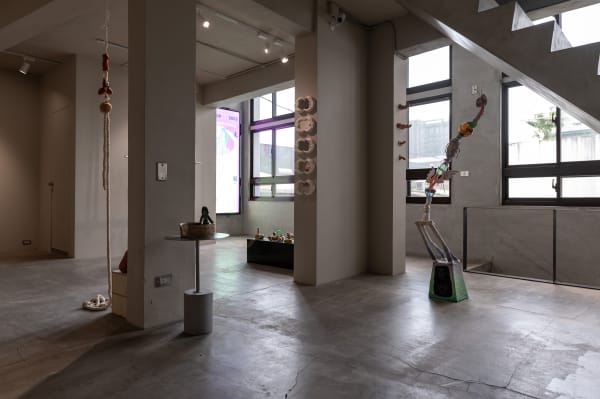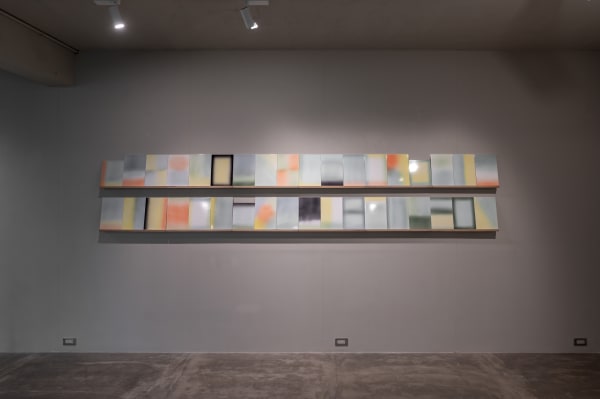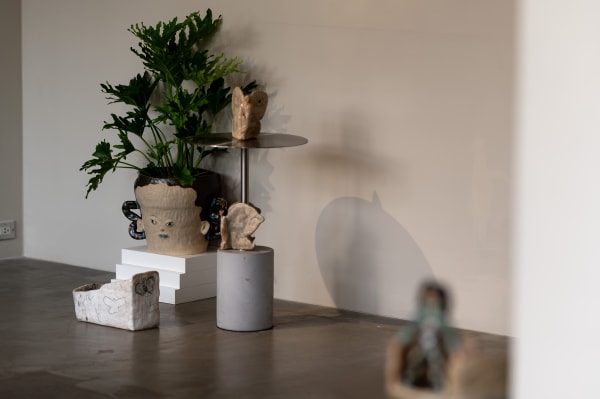Unruly Clay 2.0
Curator/ Chen Yi-Chiu and Yen Yu-Ting
"If artists can freely label their work as art, then I can freely label my own work as art criticism.” ––Lucy Lippard, Art Critic and Curator
Sculpting of body, mind, and thoughts, high-temperature firing, precise chemical or organic symbiosis and harmony - these are the enchanting yet often confounding aspects of ceramic art. Ceramics span across various domains such as design, craftsmanship, visual arts, architecture, and lifestyle. With the malleability and openness of clay, combined with the widespread foundational knowledge in the field, many artist have momentarily departed from their familiar mediums, giving birth to a series of surprising outcomes.
This material introduces a dimension of reflection by seamlessly bridging different fields and breaking free from its traditional artisanal sense. Emotionally, ceramics have even become a symbol of healing, an affinity for natural and earthy textures, a liberating symbol of relaxation through distinctive visual or sculptural impressions.
However, regardless of the duration one spends working with ceramics or the reasons behind beginning this pursuit, it's inevitably encountered at some point that ceramics possess untamed characteristics and a challenging exploration of technical processes. As artists immerse themselves in this journey, the discomfort (including physical and emotional aspects) it brings might simultaneously grow alongside the sense of contentment. Beyond being a physical manifestation of the scientific aspects of pottery-making, the phrase "unruly clay" also encompasses a sense of nonconformity and resistance in the human psyche.
It appears to be a process of training one's character, seemingly an endless endeavor. It could also represent a phase of cultivation, turning pages to explore further. The potential outcome is that the defiance of the clay is ultimately a state, not an issue. When artists willingly embrace the challenges posed by water, fire, and earth, how does clay itself respond?
Of course, we cannot make clay speak, but as Yen Yu-Ting, the initiator and participant of the "Unruly Clay" project, pointed out: "A fascinating aspect of the ceramic medium is that it magnifies a person's persona." This exhibition not only analyzes artists' attitudes toward ceramics but also aims to reverse-engineer the creative process from the final appearance of ceramics. By redefining the state of disharmony in ceramics, it seeks to truly understand ceramics, comprehend the potential forms it might take, and the messages it carries.
"I often find myself caught between hesitation, struggle, compromise, and letting go. Despite constantly pursuing the perfection of certain industrial products, I cannot accept that every piece looks the same. I continuously inject variations, imbuing them with more humanity."
"The path of working with ceramics is currently driven by 'self-satisfaction.' Sculpting in three dimensions is a hobby for me. At present, I maintain it in a state without a specific purpose, allowing it to serve as a channel for self-healing in life.”
"Ceramics are probably an extension of the body. I shape them by hand sculpting, rarely using molds. Even if I do use molds, it's with the assistance of pressure molds. The touch is intensive, shaping coils of clay to seemingly arbitrary forms that are not so arbitrary. I engage in quite a bit of sketching, so the drafts are in my mind."
"For me, the experience of working with ceramics holds an obsession with fractals. It's the same lump of clay, yet each person's touch and imagination result in different care and interpretation. It's like extracting subtly shimmering elements from a conversation—perhaps irregular edges, uneven thickness of clay walls, contracting cracks, or the uneven flow and changing luster of glaze. They can stumble or go wild in an anticipated step, and that's what I love about ceramics."
"I believe ceramics inherently possess a quiet texture or literati temperament. Therefore, I enjoy planting ribbon flowers, embedding plastic eyes, nylon beards onto ceramics, creating a slightly discordant sense, almost like a little joke."
Art critic and curator Lucy Lippard once mentioned in previous interviews, 'Art has taught me how to do what I want to do, and artists' ideas have shaped my worldview.' She observes artists from different perspectives and engages with contemporary art in various ways. For her, the work of art criticism is not merely conveyed through texts; it's more like an unrestrained and dynamic response, rather than a conclusion. The concept of 'Unruly Clay' is akin to an ongoing movement, through which we comprehend both the limitations and boundless potential of ceramics, as well as the intermediary role that artists play within it. When artists, due to their engagement in pottery, come to experience and acknowledge their own 'unruly clay,' the subsequent outcomes of facing and responding to it become even more profoundly meaningful.
Unruly Clay features artists including Lin Lulu, Thijs Jaeger, Liu Chih-hung, Huang Hung-Yu, Sun Pei-Mao, Wang Guan-Jhen, Chen Hsian-Jung, Chen Nien-Ying, Chen Ching-Ming, Yen Yu-Ting.























